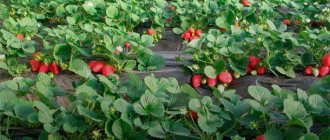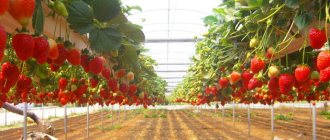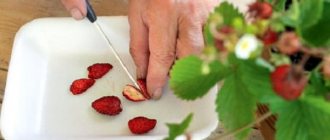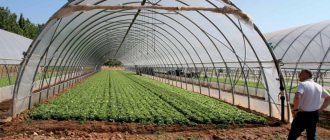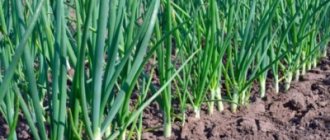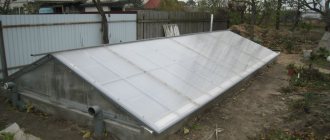Until recently, growing strawberries in winter was only possible in greenhouses with industrial capacity. Nowadays, planting strawberries in a greenhouse will not surprise anyone - modern varieties and technologies allow anyone to do this.
Of course, year-round cultivation of strawberries requires financial investments, labor and knowledge, but with enough effort it can pay off. In addition, even if you do not intend to make a business out of growing strawberries in a greenhouse, it can become an interesting hobby.
Is it possible to grow strawberries all year round?
Growing strawberries throughout the year is possible in greenhouse conditions. There are certain requirements for planting material, soil and growing season conditions, which can be met to obtain a high-quality, large-volume harvest. For example, the soil must be very fertile, since more than one crop of berries will be grown in it. In addition, not all varieties of strawberries are suitable for year-round growing.
To get a good strawberry harvest, regardless of the season, you will have to create good conditions for its development.
Experts offer a range of technologies that allow you to harvest berries in a greenhouse almost continuously. An important point is the need to apply fertilizers and special fertilizers that stimulate the growth and productivity of bushes.
Important! It is better to grow strawberries separately from other crops, having allocated a “personal” greenhouse for them, since this berry does not get along very well with other neighbors.
Basement preparation
Most often, the cellar does not have appropriate thermal standards. To reap a good harvest, it is necessary to take into account climatic conditions in the most convenient mode. In this case, a hood is installed in the room, the walls are insulated and a certain air temperature is set.
To fully ensure photosynthesis, they create an imitation of natural light, purchase and hang lighting fixtures with additional lighting. Fluorescent, energy-saving lamps or special phytolamps are excellent for these purposes.
Ordinary bright light bulbs are unsuitable, as they produce a large amount of heat, overheat the air and cause burns on the seedlings.
After the arrangement activities are completed, some preparatory work is carried out. The walls are treated with a mixture of lime and vitriol. This procedure prevents the appearance of fungal infections in the basement.
Also read: what you need to get rid of fungus in the cellar.
Advantages and disadvantages of growing all year round
You can continuously grow strawberries not only for your own needs, but also for sale.
- This is an excellent business that attracts entrepreneurs with the following points:
- high profitability, the level of which is in the range of 70–100%;
- the berries are grown in conditions protected from bad weather, they are not afraid of precipitation;
- in polycarbonate greenhouses, the bushes receive a sufficient amount of light and heat, which allows them to actively grow and bear fruit;
- in stationary greenhouses it is possible to create a unique microclimate regardless of the season, thanks to good thermal insulation;
- plants are protected from insects and pests.
- The disadvantages of greenhouse cultivation include:
- the need for an initial investment in the construction of a greenhouse and its arrangement for year-round operation;
- the taste qualities of greenhouse berries during the “season” are inferior to those grown in open ground, so selling the crop during the period of mass ripening of the crop in summer cottages can be difficult;
- Artificial pollination technology is an expensive procedure.
Harvesting
Strawberries are an incredibly tasty and healthy berry. During warm periods, the presence of fragrant fruits on the dinner table is not surprising. But when fresh fruits are served for dessert in the frosty season, skeptics often question their healthfulness and taste.
You should know. Strawberries grown in small indoor areas are not treated with pesticides and are considered an environmentally friendly product.
In a properly equipped basement, strawberry plantations produce a good harvest. Using the latest technological equipment, experienced vegetable growers sometimes collect more than one kilogram of berries, which amaze with their natural bright colors, juicy sweet taste and extraordinary aroma.
Which strawberries bear fruit all year round?
Before you start growing strawberries, you should choose a variety suitable for this, which should be:
- remontant - means that the berry crop can bear fruit several times per season, ripening occurs in waves;
- neutral, rather than long, daylight hours;
- self-pollinating modern varieties.
Day neutral varieties:
- resistant to fungal infections;
- do not depend on temperature fluctuations;
- retain their presentation for a long time;
- can be successfully transported.
These varieties include:
- Everest - a hybrid with large berries, sweet and sour, juicy;
- Queen Elizabeth II . The bushes have a small number of tendrils and rosettes, sweet and aromatic berries. The variety requires a lot of moisture and has good immunity to fungal diseases;
- Albion . The fruits are elongated, bright red. The variety is resistant to root rot, bears fruit until frost;
- Aromas . The berries are medium in size, very airy, without voids;
- Selva - it is recommended to grow in a weeping form. The fruits are large with dense pulp. The variety is resistant to diseases of the root system and leaves;
- Lyubava is a variety recommended for vertical cultivation and is drought-resistant. The berries ripen together and have a pleasant aroma.
| The following varieties are popular for growing in a greenhouse: | To grow strawberries using the forcing method, it is recommended to use the following varieties: |
|
|
Planting ready seedlings
Whatever variety of strawberry is chosen, the seedlings are prepared for planting in a similar way.
- If plants with an open root system are purchased, they are pre-soaked in a solution of growth stimulants:
- Heteroauxin,
- Epin,
- Kornevin.
Stimulants are diluted in strict accordance with the attached instructions. The growth hormones contained in the drugs have the opposite effect in case of overdose.
- It is necessary to plant seedlings up to the level of the root collar. If the soil is buried deeper, the strawberries will die.
- After planting, the containers are watered abundantly and transferred to a warm, well-lit place.
- If the seedlings were bought in pots, the plants are simply transferred to larger containers. Plants planted in this way practically do not get sick, and after a few days they begin to grow.
When planting, it is important not to cover the leaves with soil because young leaves may become diseased.
Variety of technologies
Modern gardeners have a large selection of strawberry varieties that can bear fruit throughout the year. Also, many technologies are used to obtain a constant harvest.
The most popular is Dutch. To implement it, special conditions must be created in the greenhouse , which must be maintained throughout the entire growing period:
- humidity;
- lighting;
- temperature regime.
Important! You can continuously harvest strawberries by planting early-ripening, mid-ripening and late-ripening varieties in your greenhouse.
It is thanks to the creation of a special microclimate in the greenhouse that berries are grown regardless of the season.
This article will discuss methods such as:
- forcing;
- method based on the remontant properties of berries;
- soilless technology for growing strawberries.
To increase the productivity of the plantation, strawberries are placed in several tiers
Forcing
Following this method, the growing process consists of the following steps:
- Purchase of seedling material.
- Planting it in a previously prepared greenhouse.
- Cultivation to fruiting.
- Harvesting.
- Cleaning up vegetation and used soil.
- Substrate renewal.
- Planting a new batch of strawberry seedlings.
Dutch greenhouse
Growing strawberries using Dutch technology is essentially a classic greenhouse, but with one difference. When using this technique, there is no direct contact of the berries with the soil, since the seedlings are grown in film sleeves.
The bags are filled with soil substrate - steamed peat, perlite. The substrate has a high level of moisture absorption, which exceeds its own volume four times. The incoming liquid is enriched with nutrients and is introduced into the roots, already saturated with useful substances.
Tips for the garden, vegetable garden and flower garden
Caring for raspberries in the spring at the dacha in an open area
Tree peony care and cultivation in the Moscow region
How to prepare yeast as fertilizer for seedlings
Agrotechnics of cultivation
To grow berries throughout the year, it is necessary to observe such important points as:
- planting technology;
- correct selection of soil for strawberry cultivation;
- preparation and cultivation of seedlings;
- creating a unique microclimate in a greenhouse in compliance with lighting and watering standards;
- providing proper care and fertilizing.
Video: Growing strawberries in a greenhouse
Seedlings are planted according to a 20x20 cm pattern for classic planting and in a checkerboard pattern for vertical planting.
Growing berries in a polycarbonate greenhouse has many advantages compared to more classic glass and polyethylene buildings, for example:
- it is easier to create and maintain a microclimate in the greenhouse;
- there are no difficulties with installing a heating system;
- polycarbonate protects vegetation from harmful ultraviolet radiation.
Priming
First of all, it should be said that the soil recommended for growing greenhouse berries must be nutritious.
Important! Before planting seedlings, it is necessary to prepare the soil by first disinfecting it. To do this, you can either treat the soil with a solution of potassium permanganate or sterilize it.
Sterilization can occur according to the following scheme:
- The substrate is poured into a large metal tray and covered with a lid.
- Place the container with soil either in the oven or on the fire.
- The heating temperature should be 60°C and maintained for 12 hours.
After this procedure, the disinfected soil is combined with such components as:
- sawdust;
- turf land;
- sand;
- peat;
- dry humus;
- ash;
- urea;
- mineral mixture, immediately before planting.
To prepare a special substrate, the components are combined in the following proportions: peat, soil and humus in equal parts. And then the remaining ingredients are added. To add looseness, sawdust is added. Humus, ash and added superphosphate increase the fertility of the substrate.
Harvesting and growing seedlings
Seedlings are grown from tendrils - shoots on berry bushes that are cultivated in open ground. The mustache is collected from the most powerful and prolific bushes of the previous season. Uterine rosettes are marked in the month of June by installing a peg or tying a ribbon.
We recommend learning about the use of boric acid for strawberries during flowering.
A certain number of whiskers are left on each rosette, but no more than five, and the rest are removed. Later, these shoots take root in July–August. This agrotechnical technique can be carried out both in open ground and in separate containers. With the onset of October - November, the rosettes are dug up and partially moved to the greenhouse to grow the first crop.
Those rosettes that are planned to be transplanted into the greenhouse later must be properly preserved. For this we recommend:
- Remove shoots and leaves from the seedlings, leaving only the smallest ones around the growing point. The root system is cleared of soil, after which the seedlings are packed in 50–100 units in bags and sent to a refrigerated room for storage. For these purposes, the polyethylene bags should be about 0.04-0.05 mm thick. This method is called "Frigo".
- The seedling material is transferred into separate glasses or seedling containers according to a 15x15 cm pattern. Then, careful care is provided, which, first of all, consists of regular watering. Seedlings can be left outside until frost sets in, after which they are brought indoors, fertilized and the leaves are removed.
Important! It is not recommended to use soil from beds where tomatoes, potatoes, raspberries and strawberries previously grew for the subsequent cultivation of strawberries.
Lighting
When dealing with the issue of lighting in a greenhouse, you should pay attention to:
- its intensity;
- length of daylight hours.
During the period of laying generative fruit buds, the duration of daylight hours should be short, and when the bushes begin to bloom, they require lighting for at least 15–18 hours. Thus, in regions with insufficiently long natural daylight hours, from January to March, 8–10 hours of artificial supplementary illumination are required daily. If only natural light is received in a smaller volume, for 8 hours, harvesting occurs on the 48th day.
Additional lighting will allow you to harvest faster, since receiving light for 16 hours every day, flowering occurs on the 10th day, and the berries on the bushes ripen already on the 35th
For additional lighting, sodium lamps with a power of 400 W are used, which allows the quality of light to be as close as possible to natural lighting. Lighting fixtures should be located at a distance of 1 m, which will cover an area of 1 m². To increase dispersion, it is recommended to use special reflectors.
As a rule, the lamps are turned on, adhering to the following mode:
- in the morning - from 8–11;
- in the evening - from 17 to 20 hours.
Also find out how to get rid of nematodes on strawberries.
Watering and fertilizing system
The process of growing berries in a greenhouse occurs in a more intensive mode than in open ground, therefore, plants require more strength to grow and bear fruit. They can get them from:
- organic (peat, compost, humus);
- mineral;
- combined fertilizers.
Fertilizing greenhouse berries is done twice a month, since the soil for growing strawberries must be very nutritious. Fertilizer is systematically applied in the form of:
- potassium salt –10 g;
- ammonium nitrate - 80 g;
- superphosphate –80 g;
- water - 10 l.
Important! An excess of fertilizers can negatively affect the taste of the berries.
Watering greenhouse beds should be moderate, without waterlogging the soil, to prevent the death of the plant. You can water the bushes abundantly in conditions of elevated temperature, on hot summer days, when the greenhouse is very hot. Watering is recommended to be done in the morning.
The optimal solution for irrigating strawberries in a greenhouse is a drip irrigation system , since the moisture will fall under the root of the plant, and not on the leaves and fruits. The volume of watering should be based on the consumption of 3 liters of water per day per 1 m² of greenhouse bed, that is, the length of containers with strawberry bushes must be multiplied by 3 and obtain the total water consumption for irrigation per day. This system can be homemade from a hose running along the bottom of a container, or made from plastic bottles, or can be purchased at a specialty store.
Microclimate
As for creating special conditions in the greenhouse, here it is necessary to separately say about:
- temperature conditions;
- air humidity.
The air in the greenhouse should gradually and gently warm up to higher temperatures during the growing season, since the coolness in the greenhouse will retard the development of seedlings and the bushes will begin to flower later. So, when planting seedlings, the temperature in the greenhouse is at +12˚C, during the growing process the air should be heated to +21...+22˚C, and when flowering begins - +23...+25˚C.
It will be useful for you to read about the fight against whitefly on strawberries.
Air humidity in the park plays a significant role. This indicator should not be constant, for example:
- when planting seedlings in a greenhouse, the humidity level should be high - 80–85%;
- then it decreases to 75%, until flowers appear on the bushes;
- During flowering, humidity should not exceed 70%. To adjust this parameter, ventilation vents must be created in the greenhouse for ventilation if the greenhouse is operated exclusively in the warm season. When using greenhouses in winter, it is necessary to create a simple ventilation system.
Container for seedlings
The following can be used as containers for growing strawberries in a greenhouse:
- containers made of plywood, fiberboard;
- plastic containers;
- cellular polycarbonate;
- plastic bags.
It is recommended to use a solid container for seedlings, but you should take into account the required parameters:
- height – 20–25 cm;
- width of the lower part - 15 cm;
- The width of the upper part is 25 cm.
Did you know? Strawberries have high zinc content, which increases sexual desire in both men and women. And according to scientific research, the likelihood of conception after consuming this product increases by 25%, which is why in France there is a tradition of preparing strawberry soup with cream for newlyweds.
Selection of the optimal variety
Not all varieties of crops that are easy to grow in open beds are suitable for indoor soil. You need to choose from self-pollinating strawberry varieties, which do not require bees to pollinate the flowers, because they are not indoors. Day-neutral varieties are considered good (plants bear fruit without interruption and can set fruit buds at intervals of 5-6 weeks), as well as those whose characteristics include fruit uniformity, transportability, and, of course, keeping quality.
Many varieties meet these requirements, most of them foreign selection. Varieties of greenhouse strawberries that are suitable for growing all year round: Arapahoe, Pineapple, Mount Everest, Gigantella, Tristar, Moscow Delicacy, Capri, Elsinore, Linosa, Elizabeth II, Corona, Ozark Beauty, Temptation, Red Rich, Honey, etc. .
Care
Strawberries in a greenhouse require a lot of attention, so the main care for the crop is as follows:
- regular application of fertilizers to ensure soil fertility and provide berry bushes with nutrients;
- organizing a drip irrigation system that prevents moisture from getting on the leaves;
- adjusting the level of humidity and temperature in the room depending on the stage of plant development;
- ensuring ventilation in the greenhouse, ventilation during warm seasons, which helps reduce humidity and prevents the occurrence of diseases;
- to conserve moisture in the soil, the top layer of soil is mulched with sawdust or straw;
- Some varieties of strawberries require pollination, which is done manually using a brush, however, most modern remontant varieties are self-pollinating, so you need to pay attention to this criterion when choosing a variety for planting.
Cultivating strawberries in greenhouses is a troublesome process, but year-round harvesting of berries is a fairly profitable business. In addition, berries are very healthy and in demand throughout the year.
Soil composition
Regardless of what the berries are grown in, it is necessary to lay a drainage layer. It is necessary so that moisture entering the soil does not linger in the roots. In this case, it is possible to keep the soil loose and provide sufficient oxygen access for plants. Crushed stone or gravel, which is placed at the bottom of a pot or box, is suitable for drainage. It should take up a quarter of the capacity.
Another quarter of the soil volume is occupied by sand, which is mixed with the fertile layer to improve gas exchange. Coarse sand can be poured on top of the drainage layer.
Peat and mineral fertilizers are added to the soil. They will give a start to plant growth. Otherwise, the bushes will be dwarf and the harvest will be small. Fertilizers must be of high quality: for varieties that bear fruit all year round, their quantity is doubled. Nitrogen and ammonia fertilizing is regularly applied. When the bushes take root, add superphosphate and saltpeter.
Helpful information! What soil do strawberries grow in?
Major diseases
- White rot. Occurs when humidity is too high and is practically untreatable. The diseased plant is immediately removed and burned. For prevention, you can dry the air in the greenhouse;
- White spotting. The cause is excessive watering and high humidity. It is treated with Falcon, Euparen or copper sulfate according to the instructions for them;
- Powdery mildew. The reason is high humidity and low temperature . Treated with copper sulfate or soap solution (4%). It is best to remove the diseased plant and adjust the temperature and humidity;
- Late blight. Affects the roots of the plant. Sign: redness of the roots may not be immediately detectable. Therefore, if at the end of May the plant begins to dry out, it needs to be dug up and the roots checked.
Treatment with Quadrix partially helps, but it is better to remove such a plant and carry out health procedures for the remaining plantings.
Growing strawberries in a greenhouse requires costs - labor and financial. But the result is worth it. When everyone else takes the frozen berries out of the refrigerator, you can enjoy them straight from the bush. Good luck and a delicious, bountiful harvest!
Watch the video on how to grow strawberries in a greenhouse:

